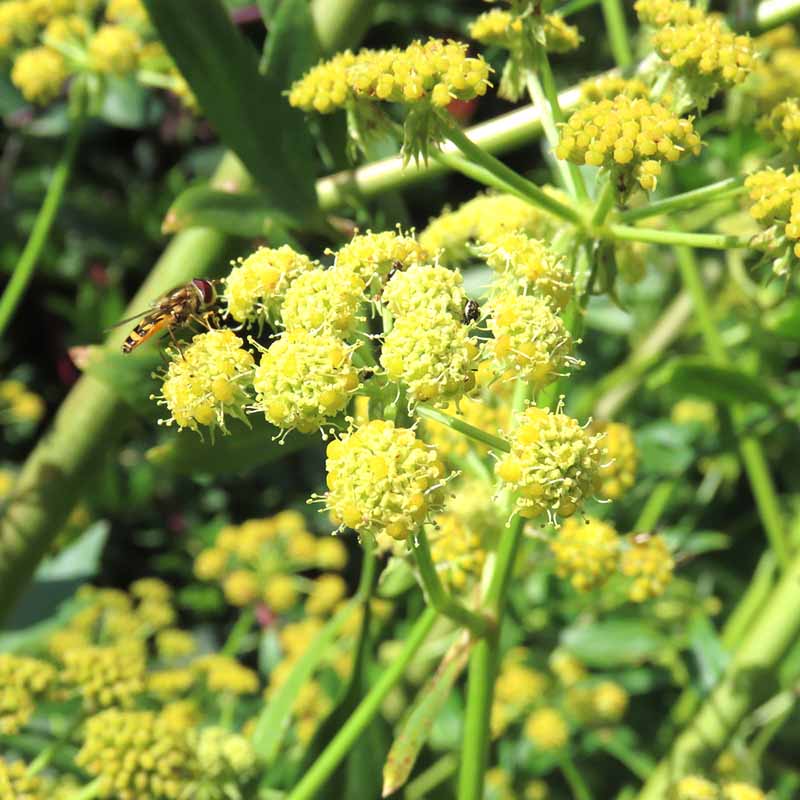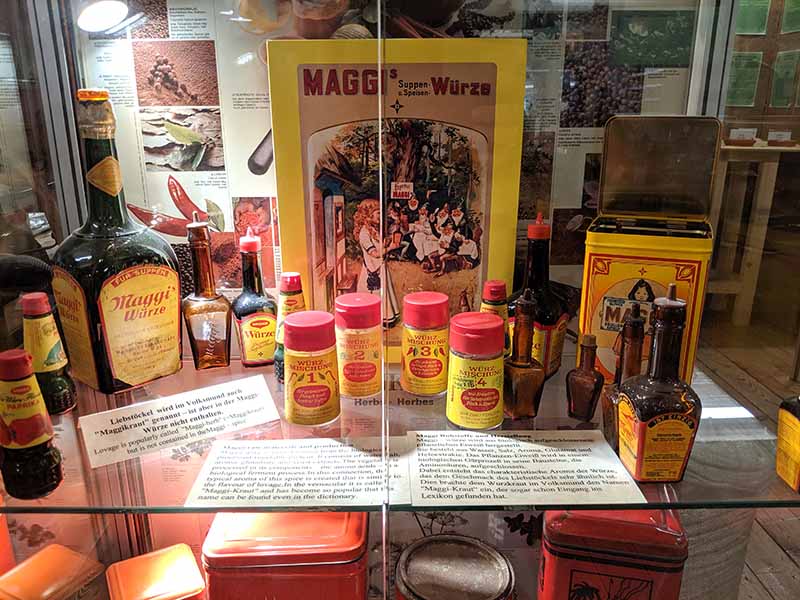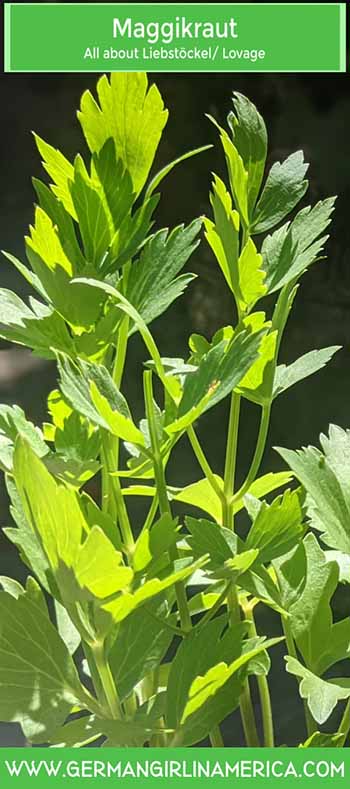When my friend Edie told me about Maggikraut, I didn’t believe her. In my world, Maggi exists in liquid form to add flavor to soups and stews. Didn’t I just visit Spicey’s Spice Museum in Hamburg and see the Maggi exhibit (yes, I do realize that the previous sentence makes me sound like a nerd, but we all know how much I love small museums). Turns out, we are both right, and lately I’ve come to appreciate the leafy flavorful Maggikraut in my garden too! What is Maggikraut? Maggikraut aka Liebstöckel in German and Lovage in English, is a fairly easy to grow herb that looks a lot like flat-leaf parsley or celery leaves, and tastes, surprisingly, like less salty Maggi.
What is Maggikraut?
The ancient Romans found Levisticum officinale in Persia, and liked it so much, they took it along everywhere they settled in Northern Europe. The leafy plant remains most popular in Germany, where it’s called Liebstöckel. And why wouldn’t it be popular? This relative of parsley and member of the carrot family is edible from leaves to root, making it an incredibly useful plant. Use the leaves and stems as an herb to brighten up soups and stews with a bright flavor that reminds me of celery with a hint of anise. Anywhere you would add celery, you can add Maggikraut… just maybe a little less. (I even read a suggestion that the stems can be used as a straw for your bloody mary… I haven’t tested that yet). The seeds act like a spice, and mostly find their way into herbal liqueurs.
The Lovage root is, well, an ugly little bulbous thing with lots of wiggley looking projections. If you don’t want to leave it in the ground to come up again next year, you can clean it, trim it, and use it like you would celery root. Save those trimmed off bits for your stocks! (Apparently 100 years ago people considered Candied Lovage Root quite the treat, but I might just stick with Gummi Bears)
But the love for this plant goes beyond the dinner table!
Hildegard of Bingen included lubestuckel in her classic Work on health and healing, Physica, saying it can be cooked with other herbs and wine to make a potion that soothes coughs (the vapors are also good for horses with a cough).
In the Middle Ages Liebstöckel plays an essential role in Love Potions. Best results come when you dig up the roots, boil them on Johannisnacht St John’s Eve, June 23rd. (St John the Baptist represents fertility, since his parents older when he was born). Then you take the potion to the church on Maria Himmelfahrt, the Assumption of Mary, on August 15th for blessing. (Results may vary) Don’t trust love potions? It’s said that a young woman should wear a bunch of Liebstöckel at her bosom to beguile men, and men wearing the herb will be irresistible to women. (I’m not sure how that would work out today, but you might attract a few chefs…)
OH! And for you ladies who want a big family? Chewing Lovage leaves on Seven Brothers Day (July 10) in the same year that you marry will insure that you have seven sons. (My Opa was one of 9 boys…..hmmm…)
References in herbal texts say Maggikraut can also be used as a digestive to calm the stomach, a diuretic, and as a cure for gas. Mixing it into a cow’s feed helps the milk flow. Also chewing the seeds apparently helps keep you awake during long church services.)
In practical terms, travelers would put Lovage in their shoes to prevent foot pain (and stinky shoes).
And my favorite tip, spreading the oil from Maggikraut seeds on your feet scares snakes away, and prevents snakebite when you are out for a stroll.

Why do Germans call Lovage Maggikraut?
I really wanted this to be an exciting story… but it’s rather simple. In 1886, when the instant flavorings craze was taking off to improve the flavor of the bland industrial diet, Julius Maggi invented his famous Maggi Flüssige Würze (Maggi Soup Seasoning). People who tasted it said … “wow, this tastes a lot like Liebestöckel”! And instead of calling Herr Maggi’s invention Flüssige Liebestöckel, the herb got the nickname Maggikraut. Fun fact, you won’t find any Maggikraut in Maggi.
Quick note- When people mention Maggi, they are usually referring to the liquid seasoning. The dark brown liquid resembles Soy Sauce, and generally gets used the same way. Pour each of the liquids into bowls, and you’d have a tricky time telling them apart. (At the same time, making that comparison has started more unreasonable arguments on Facebook than my Oma’s Potato Salad recipe…). How are they different? Soy Sauce is made from soy… Maggi on the other hand comes from fermented wheat protein and is loaded with glutamic acids, and tastes more meaty. Both contain loads of sodium (so use sparingly). Oddly, Maggikraut tastes like Maggi, but without the salt.

The Maggi exhibit from Spicey’s Spice museum in Hamburg
How to Grow Maggikraut
Maggikraut grows bigger than you might expect, topping at out 6- 8 Feet! (I’m keeping mine in a pot). And the pretty yellow flowers attract all sorts of pollinators.
Fortunately, Maggikraut/Lovage grows without a lot of care. It likes sun, but grows in partial shade if you live somewhere warm. Make sure your soil is nutrient-rich, and give the plant a lot of water and space (it does get big). Learn more here- How to grow Lovage
Lovage SEEDS Lovage Herb Heirloom Seeds, Medicinal Herb, Herb Garden
Lovage Herb Heirloom Seeds, Medicinal Herb, Herb Garden Lovage Root, Organic
Lovage Root, Organic Organic Lovage Leaf | Lovage Leaf Tea | Lovage Leaves | Levisticum Officinale Folia | Organic Dried Herbs | Herbal Products | Natural
Organic Lovage Leaf | Lovage Leaf Tea | Lovage Leaves | Levisticum Officinale Folia | Organic Dried Herbs | Herbal Products | Natural Dried organic Lovage Leaf / Available from 1oz-4lbs / Herbal tea / Levisticum Officinale
Dried organic Lovage Leaf / Available from 1oz-4lbs / Herbal tea / Levisticum Officinale








Hi Karen.
I just love all your newsletters. You do so much research and share it with all of us. I learn so much from you. Till I got your newsletter today, I never heard of Maggikraut before. Do you type all your research up? I don’t know where you find all the time to keep up with your housework and typing stories, plus taking trips to Germany. You sound like Wonder women to me. Thank you for the responds to the letter I send you. Wishing all of you a delightful Mothers day. This year my birthday and mothers day fall on the same day. My daughters think the only have to buy me one present. Oh no I said, I want 2 presents. One for my birthday and one for mothers day. Of course I’m kidding, I really don’t need anything. Matter of fact I been telling them for a few years now that I don’t want to celebrate my birthday anymore. Told them I’m not celebrating getting more wrinkles. Of course the don’t listen to me. Been getting presents on every birthday and mothers day. I refuse to accept Knick knacks. I got my reasons for that. Pleasant day wishes to all of you.
Love the info on lovage which I have been growing for years near Seattle. I grew red currants here for years as well after growing them became legal here. Earlier they were not allowed because they are a vector for disease for some native plant. I. Don’t remember what.
Lovage is one of my favorite herbs. Seattle is so much like Germany, I can see how you are able to grow both Johannisbeeren and Lovage well
I had never heard of that herb until I just received my current Dr. Oetker Schulkockbuch. It mentioned Liebtoeckel and several other ingredients that didn’t mean a thing to me. I must have asked the wrong kind of question the first time, because one answer just said “lovage” and the others were trying to sell me German/English dictionaries. So thank you for your newsy, enlightening, and funny explanation what Liebstoeckel/Maggi is. Having brown thumbs I will restrain myself and not put a pour plant though such an ordeal. I still use my old Dr. Oetker Schule Koch Buch from 1958 and was hoping to get a newer version where the baking instructions were oriented towards using mixers, blenders and food processors. It’s a great cookbook, but absolutely doesn’t have anything to do with baking. Thanks again from one German Girl in America to another for a great explanation and have a blessed day.
Thank you! (I still use my old Dr Oetker … https://germangirlinamerica.com/dr-oetker-schulkochbuch-kitchen-lifeline/)